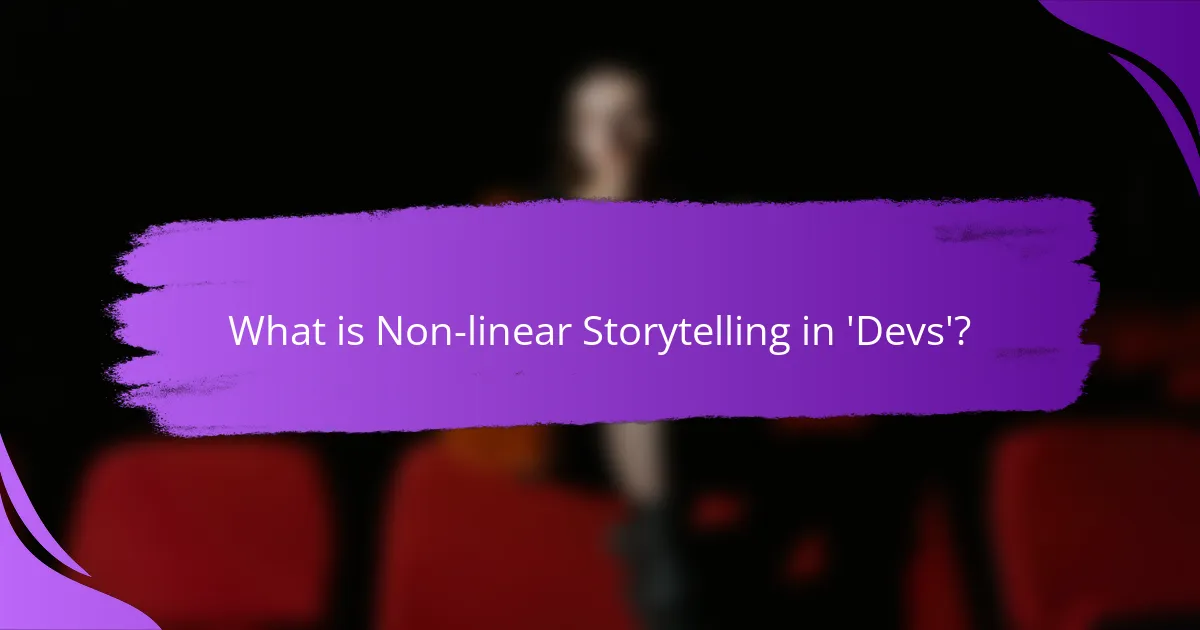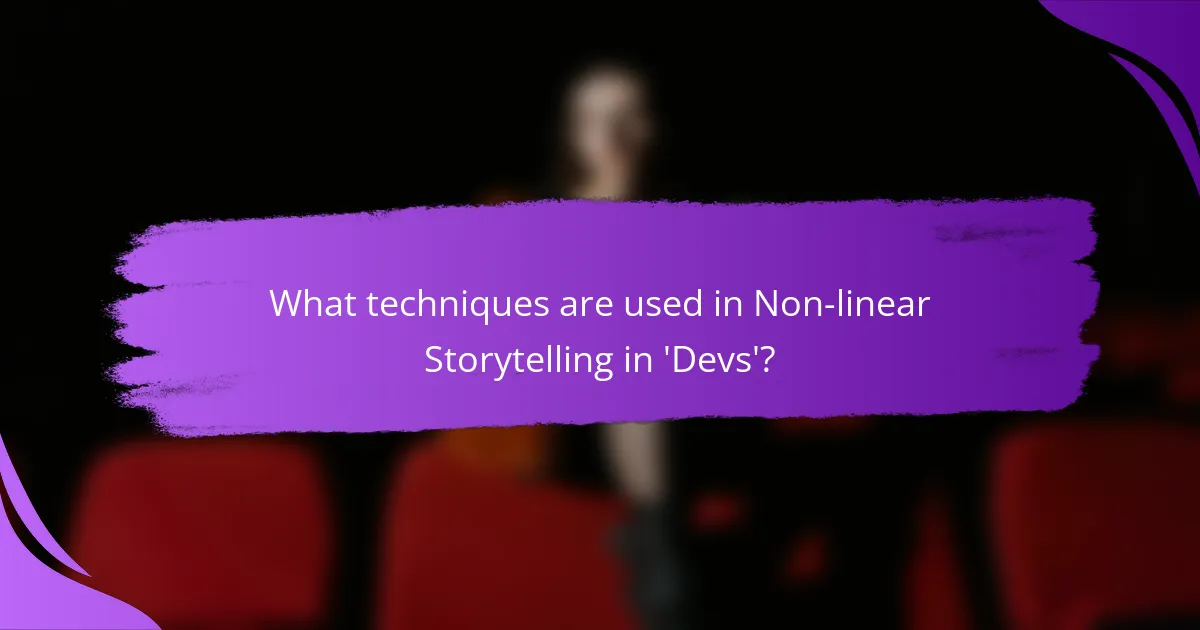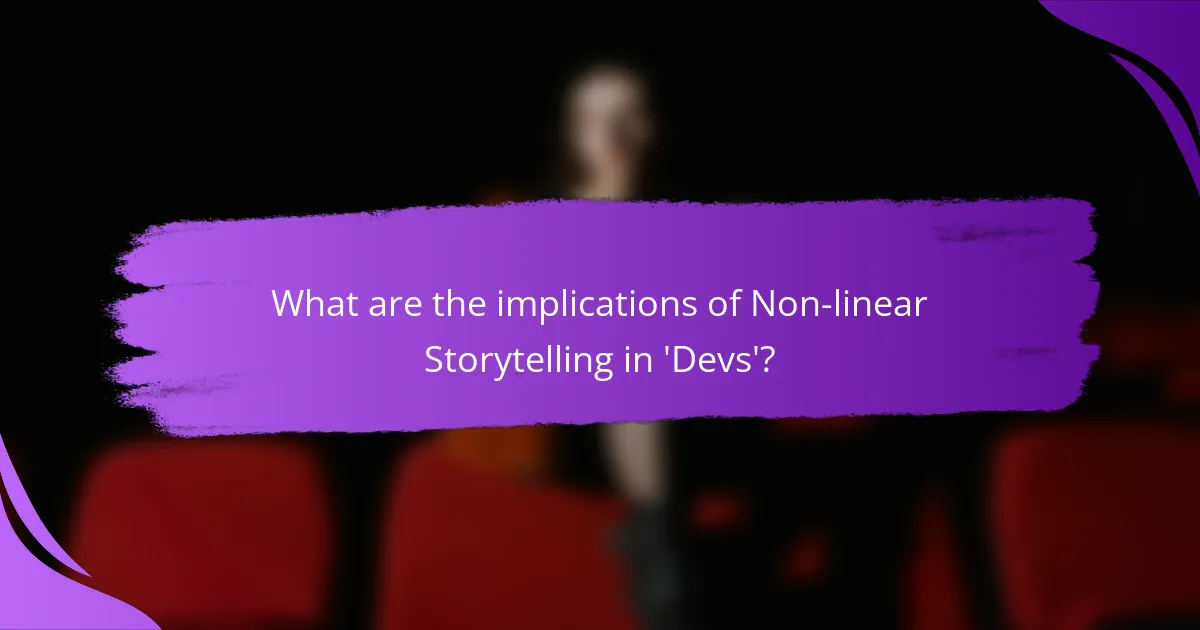The article focuses on the use of non-linear storytelling in the television series ‘Devs,’ which employs a narrative structure that does not follow a chronological order. This approach allows for the exploration of complex themes such as determinism and free will through fragmented timelines, flashbacks, and parallel narratives. Key techniques highlighted include time manipulation, visual symbolism, and philosophical dialogues, all of which enhance thematic depth and character development. The non-linear storytelling method not only creates suspense but also encourages viewers to engage actively with the plot, ultimately deepening the philosophical questions presented in the series.

What is Non-linear Storytelling in ‘Devs’?
Non-linear storytelling in ‘Devs’ refers to a narrative structure that does not follow a chronological order. This approach allows the series to explore themes of determinism and free will through fragmented timelines. The story unfolds through flashbacks and parallel timelines, revealing character motivations and plot developments in a non-sequential manner. This technique enhances the viewer’s understanding of the complex philosophical questions posed by the narrative. The use of non-linear storytelling creates suspense and invites viewers to piece together the timeline themselves. This method is pivotal in illustrating the show’s central themes and character arcs.
How does Non-linear Storytelling shape the narrative of ‘Devs’?
Non-linear storytelling in ‘Devs’ shapes the narrative by creating a complex structure that enhances thematic depth. This technique allows the series to explore multiple timelines and perspectives simultaneously. As a result, viewers gain insight into characters’ motivations and choices. The non-linear approach also emphasizes the philosophical themes of determinism and free will. By presenting events out of chronological order, the narrative invites viewers to engage actively with the plot. This structure mirrors the technological concepts explored in the show, such as quantum computing. Overall, non-linear storytelling enriches the viewer’s experience and understanding of the narrative’s core themes.
What are the key characteristics of Non-linear Storytelling in ‘Devs’?
Non-linear storytelling in ‘Devs’ is characterized by its fragmented narrative structure. The series presents events out of chronological order. This technique creates suspense and intrigue for the audience. It allows viewers to piece together the story gradually. The use of flashbacks and flash-forwards enhances thematic depth. Each character’s perspective is explored through non-linear sequences. This approach emphasizes the complexity of time and choice. Additionally, it reflects the show’s exploration of determinism and free will.
How does the structure influence viewer perception in ‘Devs’?
The structure of ‘Devs’ significantly influences viewer perception by employing a non-linear narrative. This approach creates suspense and encourages active engagement from the audience. Viewers must piece together the timeline, which enhances their investment in the story. The fragmented storytelling allows for multiple interpretations of events and themes. Additionally, the structure mirrors the show’s exploration of determinism and free will. By presenting events out of chronological order, the series emphasizes the complexity of its philosophical themes. This technique also deepens emotional resonance as viewers connect with characters’ motivations and dilemmas. Overall, the non-linear structure shapes how viewers understand and relate to the narrative.
Why is Non-linear Storytelling significant in ‘Devs’?
Non-linear storytelling is significant in ‘Devs’ because it enhances the narrative complexity and thematic exploration. This structure allows viewers to engage with the plot in a non-sequential manner. It reflects the show’s central themes of determinism and free will. By presenting events out of order, the series challenges traditional storytelling. This approach encourages viewers to piece together the timeline and meaning. It also emphasizes the interconnectedness of characters’ choices. The non-linear format aligns with the technological concepts explored in the narrative. Overall, it deepens the viewer’s understanding of the philosophical questions posed by the storyline.
What themes are explored through Non-linear Storytelling in ‘Devs’?
Non-linear storytelling in ‘Devs’ explores themes of determinism, free will, and the nature of reality. The series presents a complex narrative structure that intertwines past, present, and future events. This method emphasizes the characters’ struggles with fate versus choice. It also raises questions about technology’s role in shaping human experience. The narrative reveals how knowledge of the future impacts decision-making. By presenting events out of chronological order, the series enhances viewer engagement and reflection. Ultimately, ‘Devs’ challenges the audience to consider the implications of a deterministic universe.
How does Non-linear Storytelling enhance character development in ‘Devs’?
Non-linear storytelling enhances character development in ‘Devs’ by revealing motivations and backstories in a fragmented manner. This approach allows viewers to piece together character arcs over time. Key events are shown out of chronological order, creating suspense and intrigue. As a result, characters are seen from multiple perspectives, deepening audience engagement. For example, the protagonist’s journey is interwoven with flashbacks that illuminate personal struggles. This technique fosters a more complex understanding of each character’s choices and consequences. Ultimately, non-linear storytelling enriches the narrative by highlighting the interplay between fate and free will.

What techniques are used in Non-linear Storytelling in ‘Devs’?
‘Devs’ employs several techniques in non-linear storytelling. One technique is the use of flashbacks. These flashbacks reveal character backstories and motivations. Another technique is parallel narratives. This technique juxtaposes multiple storylines to enhance thematic depth. The series also utilizes time manipulation. Time manipulation allows viewers to experience events out of chronological order.
Visual symbolism is another important technique. Symbolic imagery reinforces key themes and concepts. Additionally, the series incorporates philosophical dialogues. These dialogues provoke thought and deepen the narrative complexity. Overall, these techniques create a rich, layered storytelling experience in ‘Devs’.
How do flashbacks and flash-forwards function in ‘Devs’?
Flashbacks and flash-forwards in ‘Devs’ serve to deepen character development and enhance thematic complexity. Flashbacks reveal critical backstory elements, such as the protagonist’s past and motivations. These moments provide context for the character’s present actions and emotional state. Flash-forwards, conversely, offer glimpses into potential futures, raising questions about fate and determinism. They create suspense and foreshadow significant plot developments. Together, these techniques illustrate the show’s exploration of time and choice. The non-linear structure allows viewers to engage with the narrative on multiple levels, prompting reflection on the nature of reality.
What role do temporal shifts play in the storytelling of ‘Devs’?
Temporal shifts are crucial in the storytelling of ‘Devs’. They create a non-linear narrative structure that enhances thematic depth. The show uses flashbacks and future glimpses to explore character motivations. This technique allows viewers to understand the consequences of actions across time. Temporal shifts also emphasize the deterministic nature of the plot. They illustrate the intertwining of free will and fate. For instance, the protagonist’s choices are revealed through these shifts. This storytelling approach deepens the philosophical questions presented in the series. Overall, temporal shifts enrich the narrative complexity and viewer engagement.
How does the use of parallel narratives affect the audience’s understanding?
The use of parallel narratives enhances the audience’s understanding by providing multiple perspectives on a central theme. This storytelling technique allows viewers to compare and contrast different characters’ experiences. It deepens emotional engagement as the audience witnesses how choices affect outcomes. Parallel narratives also create a richer context for the main storyline. By interweaving these narratives, the audience gains insights into motivations and consequences. This method encourages critical thinking and analysis of the narrative structure. In “Devs,” the dual timelines illustrate the interplay between technology and fate, reinforcing the show’s central themes. Research indicates that non-linear storytelling can improve comprehension and retention of complex narratives.
What visual and auditory elements support Non-linear Storytelling in ‘Devs’?
Visual elements in ‘Devs’ include symmetrical compositions and contrasting colors. These elements create a sense of order amidst chaos. The use of reflections and mirrors enhances the theme of duality. Auditory elements feature a minimalist score that underscores tension. Sound design incorporates ambient noise to evoke a feeling of isolation. Together, these elements support the show’s non-linear narrative. They emphasize the complexity of time and choice within the story. The visual and auditory choices reinforce the thematic depth of technological determinism.
How does cinematography contribute to the Non-linear narrative?
Cinematography enhances non-linear narratives by visually representing time shifts and fragmented storytelling. It employs techniques like flashbacks, varying shot compositions, and color grading to signify changes in time and perspective. For instance, in ‘Devs’, the use of close-ups creates emotional connections while altering the viewer’s perception of the timeline. Additionally, specific camera movements can signify transitions between different narrative threads. The strategic use of lighting can also emphasize the mood of various scenes, reinforcing the non-linear structure. This visual storytelling engages the audience, encouraging them to piece together the narrative puzzle actively.
What is the impact of sound design on the storytelling experience?
Sound design significantly enhances the storytelling experience by creating an immersive atmosphere. It establishes mood and tone, guiding audience emotions throughout the narrative. For instance, in ‘Devs,’ sound design complements the non-linear storytelling structure. It helps convey complex themes such as determinism and free will. Specific sound cues can foreshadow events or highlight pivotal moments. Research shows that sound influences memory retention, making stories more impactful. A study from the University of Southern California found that sound enhances emotional engagement by 50%. Thus, effective sound design is crucial for deepening the storytelling experience.

What are the implications of Non-linear Storytelling in ‘Devs’?
Non-linear storytelling in ‘Devs’ allows for complex narrative exploration and thematic depth. It challenges traditional storytelling by presenting events out of chronological order. This structure encourages viewers to engage actively with the plot. It emphasizes themes of determinism and free will by showcasing multiple timelines and outcomes. The non-linear approach reflects the show’s focus on technology’s impact on human experience. By revealing key plot points at different times, it enhances suspense and intrigue. This technique also deepens character development, as viewers see different facets of characters across timelines. Overall, the implications of non-linear storytelling in ‘Devs’ enrich the viewing experience and provoke deeper philosophical questions.
How does Non-linear Storytelling challenge traditional narrative forms?
Non-linear storytelling challenges traditional narrative forms by disrupting chronological order. It allows for multiple perspectives and timelines to coexist. This method creates a more complex narrative structure. Traditional narratives typically follow a linear progression from beginning to end. Non-linear storytelling invites viewers to engage actively with the plot. It requires them to piece together the story from fragmented elements. This approach can enhance thematic depth and character development. In ‘Devs’, for instance, the non-linear structure emphasizes themes of fate and determinism.
What are the potential drawbacks of Non-linear Storytelling in ‘Devs’?
Non-linear storytelling in ‘Devs’ can lead to confusion among viewers. The fragmented narrative structure may hinder audience engagement. Some viewers might struggle to piece together the story’s timeline. This can result in a disconnection from character motivations. Additionally, the complexity of the plot may alienate casual viewers. The non-linear approach can also obscure thematic clarity. As a result, key messages may be lost or misinterpreted. Overall, these drawbacks can detract from the storytelling experience.
How can audiences engage with Non-linear narratives effectively?
Audiences can engage with non-linear narratives effectively by actively piecing together the story’s fragments. This requires attention to detail and an understanding of the narrative’s structure. Engaging with multiple timelines or perspectives enhances comprehension. Viewers should take notes or discuss their interpretations with others. Analyzing character motivations across different timelines deepens understanding. Familiarity with the genre can also aid in navigation. Research shows that audiences who actively participate in narrative construction report higher satisfaction levels. Engaging with supplementary materials, such as interviews or analyses, can provide additional context.
What lessons can be learned from the Non-linear Storytelling in ‘Devs’?
Non-linear storytelling in ‘Devs’ teaches the importance of perspective in narrative. It allows viewers to see events from multiple angles. This structure enhances emotional engagement with characters. It also invites deeper analysis of themes such as determinism and free will. The fragmented timeline creates suspense and intrigue. It encourages audiences to piece together the storyline actively. This method reflects the complexity of reality and human experience. Ultimately, it challenges traditional narrative forms and enriches storytelling.
How can writers apply Non-linear Storytelling techniques in their own works?
Writers can apply non-linear storytelling techniques by structuring their narratives in a non-chronological order. This can involve starting the story at the end or in the middle, then using flashbacks or flash-forwards to fill in details. Writers can also create multiple perspectives by presenting events from different characters’ viewpoints. This technique can enhance emotional depth and complexity in the narrative.
Incorporating fragmented timelines allows writers to build suspense and engage readers by revealing information gradually. Writers can utilize thematic motifs that recur throughout the story, linking disparate scenes and enhancing coherence. This method can create a richer, more immersive experience for the audience.
Examples of successful non-linear storytelling can be found in works like “Pulp Fiction” by Quentin Tarantino and “The Sound and the Fury” by William Faulkner. These examples illustrate how non-linear structures can effectively convey complex themes and character development.
What best practices should be considered when using Non-linear Storytelling?
Best practices for non-linear storytelling include establishing a clear narrative structure. This structure helps guide the audience through the fragmented timeline. Use visual cues to indicate shifts in time and perspective. This aids in maintaining clarity and engagement. Incorporate character development across different timelines. This enriches the audience’s understanding of motivations. Ensure that each segment contributes to the overall theme. This creates cohesion despite the non-linear format. Test the narrative with focus groups to gather feedback. This can reveal areas of confusion or disconnection. Overall, clarity, character depth, thematic consistency, and audience engagement are key.
The main entity of the article is non-linear storytelling in the television series ‘Devs.’ The article explores how this narrative structure enhances thematic depth by presenting events out of chronological order, allowing for a complex exploration of determinism and free will. Key characteristics, techniques, and their impact on viewer perception and character development are analyzed, along with the challenges and best practices associated with non-linear storytelling. The discussion includes the significance of visual and auditory elements, temporal shifts, and parallel narratives in enriching the overall narrative experience.